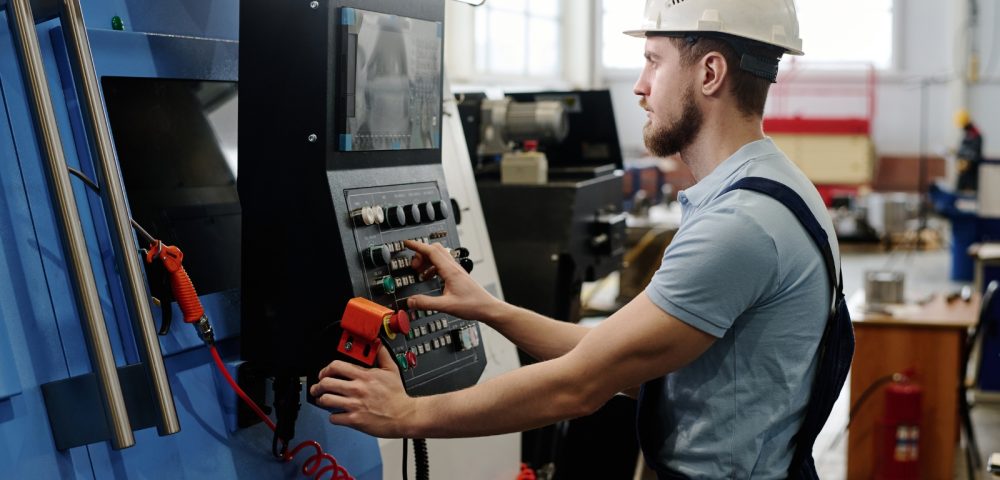Even if you feel like your industrial machines just break, they hint, shake, and whisper before they collapse! The problem is you were not listening. That is where predictive maintenance vibration analysis steps in. This is real tech that turns every pulse of your machinery into valuable insight. If you want to stop reacting and start preventing, this is your ideal path in this digital age. But how does it work? What tools do you need? And how soon can you see results?
In this article, we discover how predictive maintenance vibration analysis transforms shaky machines into predictable performers.
In this article, we discover how predictive maintenance vibration analysis transforms shaky machines into predictable performers.
We will explore
- What is Vibration Analysis in Maintenance?
- Where is Vibration Analysis Used?
- How to Conduct a Vibration Analysis
- Define Objectives
- Select Equipment for Monitoring
- Choose the Right Sensors and Tools
- Install Sensors Correctly
- Set Baseline Vibration Data
- Collect Vibration Data
- Analyse Frequency Spectrum
- Compare with Baseline and Standards
- Diagnose Faults
- Recommend Corrective Actions
- Document and Report Findings
- Schedule Follow-Up Monitoring
- Benefits of Conducting a Vibration Analysis as a Proactive Approach
- Saving Your Machines by Conducting Proper Vibration Analysis via Digital Tools
What is Vibration Analysis in Maintenance?

- It is a process that helps asset maintenance units catch equipment problems early before they turn into breakdowns. It focuses on machines with rotating parts, like pumps, fans, compressors, or turbines, as those parts usually show signs of trouble through vibration.
- When these parts start wearing down, they shake differently than normal, and sensors detect that shift across all three movement directions. A vibration analyser reads this data, compares it with past performance and known warning patterns, and helps pinpoint exactly what is going wrong.
- That means vibration analysis spots those changes early, so the team can fix things fast, keep production steady, and avoid scrapping materials or missing deadlines.
Where is Vibration Analysis Used?

Vibration analysis takes place mainly in industries that depend on heavy machines with rotating parts, like factories, plants, and production lines. Technicians use it to monitor the health of parts such as bearings, gears, shafts, and freewheels because these components face the most stress and wear during operation.
It also plays a huge role in keeping gearboxes, motors, fans, and drive trains running smoothly. These machines power essential systems, so even a small fault can lead to bigger issues fast.
It also plays a huge role in keeping gearboxes, motors, fans, and drive trains running smoothly. These machines power essential systems, so even a small fault can lead to bigger issues fast.
How to Conduct a Vibration Analysis

Define Objectives
Start strong by figuring out what you want to solve. Do you need to catch signs of imbalance, misalignment, loose parts, or worn-out bearings?
These small issues grow fast if no one pays attention. Study how the machine runs, how often it breaks down, and under what conditions. Look into its failure history and performance habits. Set a clear purpose, so every step you take later actually solves something.
These small issues grow fast if no one pays attention. Study how the machine runs, how often it breaks down, and under what conditions. Look into its failure history and performance habits. Set a clear purpose, so every step you take later actually solves something.
Select Equipment for Monitoring
Focus on equipment that plays a huge part in production, breaks down often, or costs a lot to repair. Look at things like how often they run, the stress they handle, and what happens if they suddenly stop.
This helps you avoid spreading resources too thin. Machines with rotating parts like motors or gearboxes come first. Make a list and rank them based on impact.
This helps you avoid spreading resources too thin. Machines with rotating parts like motors or gearboxes come first. Make a list and rank them based on impact.
Choose the Right Sensors and Tools
Use the right tools for the right job, or the whole test could give you bad data. Think about the machine type, how fast it runs, and what faults you’re trying to catch.
Use accelerometers to measure fast, high-frequency movements like bearing issues. For slower-moving parts, go with velocity or displacement sensors. Choose tools that work well with the machine’s vibration patterns and direction of movement.
Use accelerometers to measure fast, high-frequency movements like bearing issues. For slower-moving parts, go with velocity or displacement sensors. Choose tools that work well with the machine’s vibration patterns and direction of movement.
Install Sensors Correctly
Always mount sensors in directions that matter most: horizontal, vertical, and axial. Most issues show up near bearings or coupling points, so attach the sensors there using the right method, like bolts, magnets, or adhesive pads.
Make sure they are tight and secure to avoid false readings. Avoid rough or rusty surfaces, since those mess with data.
Make sure they are tight and secure to avoid false readings. Avoid rough or rusty surfaces, since those mess with data.
Set Baseline Vibration Data
First, run the machine under usual working conditions and record the vibration data. This baseline becomes your comparison point for all future checks.
Without it, you will not know if something is getting worse or staying the same. Keep the data organised and labelled clearly. Include things like date, machine type, load, and RPM. If conditions stay consistent, your baseline will stay useful for a long time.
Without it, you will not know if something is getting worse or staying the same. Keep the data organised and labelled clearly. Include things like date, machine type, load, and RPM. If conditions stay consistent, your baseline will stay useful for a long time.
Collect Vibration Data
Once sensors are in place and the baseline is ready, it is time to collect data regularly. Use handheld devices or built-in monitoring systems, depending on your setup. Stick to a steady schedule, daily, weekly, or monthly, based on how fast the machine wears out.
Make sure the machine runs under the same load and speed each time to keep things consistent. Track vibration in all three axes, and log every reading with the time and operating condition.
Make sure the machine runs under the same load and speed each time to keep things consistent. Track vibration in all three axes, and log every reading with the time and operating condition.
Analyse Frequency Spectrum
Use Fast Fourier Transform (FFT) to convert time-based signals into a frequency spectrum. This shows where specific issues might hide, like one spike pointing to imbalance and another hinting at a bad bearing.
Patterns jump out when you map data into frequency, and you can match those spikes to known problem signatures. Look closely at the shape, size, and repetition of peaks.
Patterns jump out when you map data into frequency, and you can match those spikes to known problem signatures. Look closely at the shape, size, and repetition of peaks.
Compare with Baseline and Standards
Once the frequency data is ready, stack it next to your baseline and check for differences. Look for spikes that did not exist before or levels that keep creeping higher. Match those patterns against international standards like ISO 10816, or use manufacturer limits to see if things are out of line.
Every machine has its own ‘normal,’ so no need to panic over tiny shifts. Focus on changes that keep repeating or growing.
Every machine has its own ‘normal,’ so no need to panic over tiny shifts. Focus on changes that keep repeating or growing.
Diagnose Faults
Now that you have spotted odd readings, it is time to figure out what they mean.
Peaks at 1× RPM normally point to imbalance. If you see 2× or 3× RPM, you might have misalignment.
Sharp, high-frequency spikes usually hint at bearing wear: look for BPFO, BPFI, or cage frequency signs. Each issue leaves its own fingerprint, so match it to known vibration patterns. Use your experience, database, or software tools to interpret the signals.
Peaks at 1× RPM normally point to imbalance. If you see 2× or 3× RPM, you might have misalignment.
Sharp, high-frequency spikes usually hint at bearing wear: look for BPFO, BPFI, or cage frequency signs. Each issue leaves its own fingerprint, so match it to known vibration patterns. Use your experience, database, or software tools to interpret the signals.
Recommend Corrective Actions
Once you understand the fault, decide what to do next. If the machine is out of balance, suggest a rebalancing procedure.
If parts seem loose, recommend tightening or realignment. For worn bearings, plan a replacement before failure. Write your fixes clearly and connect them to the data you found. Don’t suggest huge changes unless the issue calls for it.
It is better to keep solutions focused and actionable. Think about downtime, cost, and urgency when planning your move.
If parts seem loose, recommend tightening or realignment. For worn bearings, plan a replacement before failure. Write your fixes clearly and connect them to the data you found. Don’t suggest huge changes unless the issue calls for it.
It is better to keep solutions focused and actionable. Think about downtime, cost, and urgency when planning your move.
Document and Report Findings
Now you need to write everything down. Include sensor positions, graphs, spectrum analysis, fault types, and suggested repairs.
Add dates, technician names, and machine IDs. Use clear language so even someone new can understand what is happening. Attach visuals like charts or photos when possible. A solid report helps others learn from it and stay alert for similar patterns later.
Add dates, technician names, and machine IDs. Use clear language so even someone new can understand what is happening. Attach visuals like charts or photos when possible. A solid report helps others learn from it and stay alert for similar patterns later.
Schedule Follow-Up Monitoring
Once repairs finish or you have taken action, plan your next steps.
Now you need to set dates to monitor the same machine again and make sure the fix worked. Use the same sensor points and methods to keep things consistent.
Track the machine’s condition over time and look for improvement or new problems. Don’t wait for a failure to check again.
Now you need to set dates to monitor the same machine again and make sure the fix worked. Use the same sensor points and methods to keep things consistent.
Track the machine’s condition over time and look for improvement or new problems. Don’t wait for a failure to check again.
Benefits of Conducting a Vibration Analysis as a Proactive Approach

- Technicians spot hidden machine problems, which helps stop small faults before they turn into major breakdowns.
- Maintenance teams cut down surprise downtime because vibration checks let them plan repairs before the machine crashes.
- Companies avoid wasting money on emergency fixes since vibration analysis helps them fix the exact issue without guessing.
- Machines last longer and perform better when teams keep an eye on their vibration levels and act before damage spreads.
- Everyone saves time during maintenance because vibration data points straight to the issue.
Saving Your Machines by Conducting Proper Vibration Analysis via Digital Tools

Vibration does not lie, and neither do data-driven decisions. If you opt for a solid digital asset solution that has Predictive Maintenance capabilities, it transforms raw vibration into real-time foresight, saving machines and sanity. However, you need to collaborate with an industry expert for the best possible outcome. On one hand, you will save your machines, and on the other hand, you will save a million dollars.







